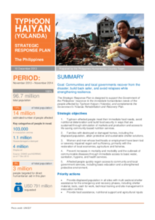Typhoon Haiyan (Yolanda) is among the most powerful storms ever recorded. It made landfall in the morning of the 8th November in Guiuan, Eastern Samar province, causing extensive damage to life, housing, livelihoods and infrastructure across nine of the Philippines’ poorest provinces. The islands of Leyte and Samar were hardest hit: 90 percent of the infrastructure of Leyte’s largest urban center, Tacoloban City, was destroyed. Philippines authorities estimate that 14 million people have been affected, 4 million displaced, 1.1 million have had their houses damaged or destroyed.
A Strategic Response Plan was developed and designed to support the Government of the Philippines’ response to the immediate humanitarian needs of the people affected by this disaster, and complements the Government’s Yolanda Rehabilitation and Recovery Plan.
Strategic Objective 4: Affected people quickly regain access to community and local government services including basic education and a strengthened protective environment.
Cluster Objective 4C: Girls and boys are protected from violence, exploitation (including trafficking), abuse and neglect; and the existing national, provincial and local mechanisms for child protection are strengthened.
Top priority activities include: Facilitate and support family unity and prevent separation of children from caregivers as well as all forms of violence, exploitation, abuse and neglect.
Cluster Objective 4E: Support implementation of government policies in relation to displacement / resettlement in line with the Guiding Principles on Internal Displacement and other international standards.
Top priority Activities include: Support DSWD presence and registration mechanisms in areas of origin, secondary movement and return areas. This activity is key to ensure children are not separated from their families without proper assessment and consideration of the best interest of each child, and that placement in out of home care outside of the affected areas can also be detected.

